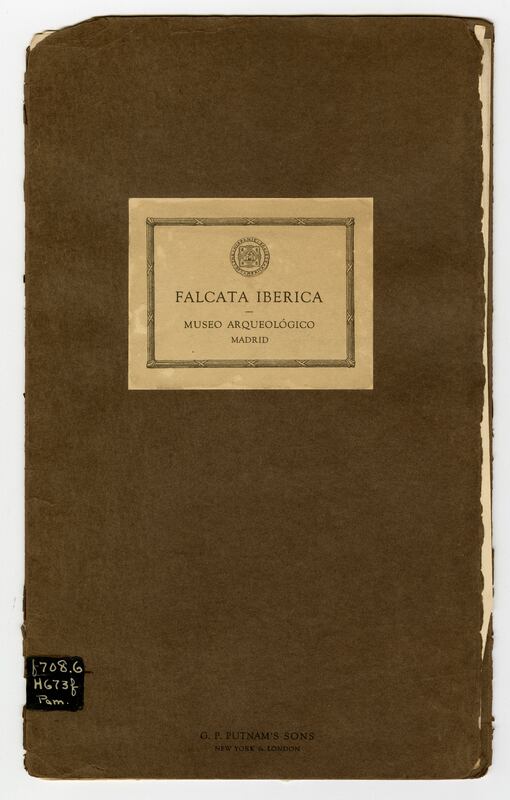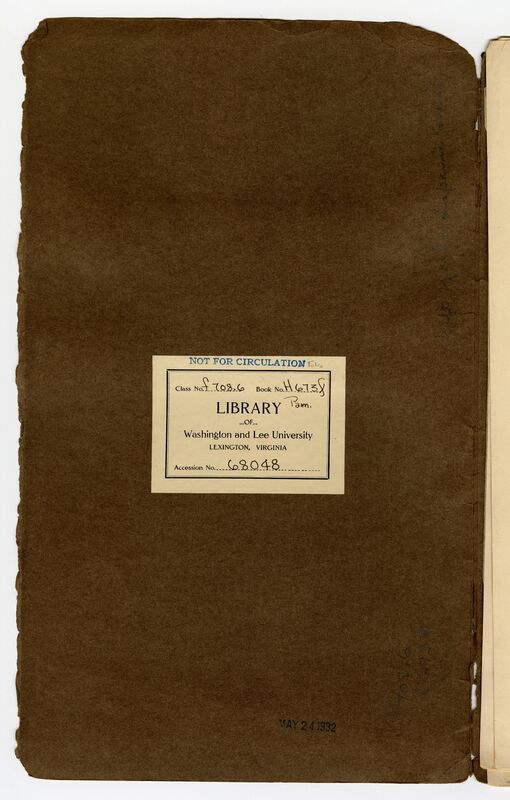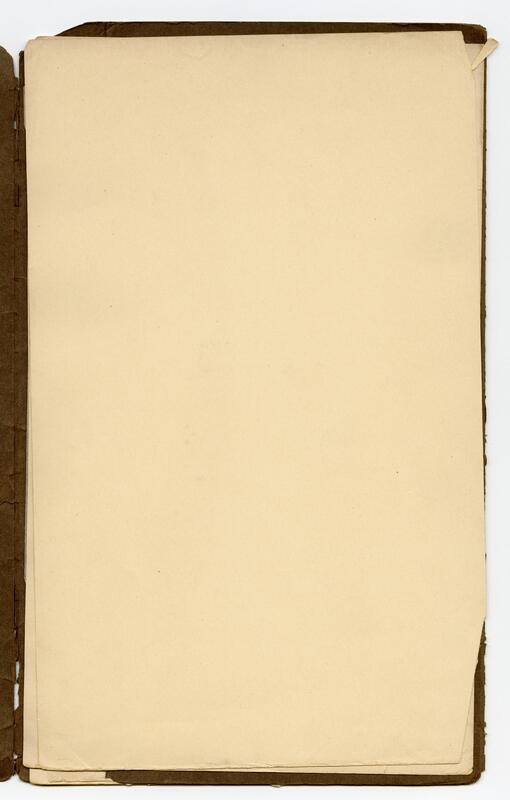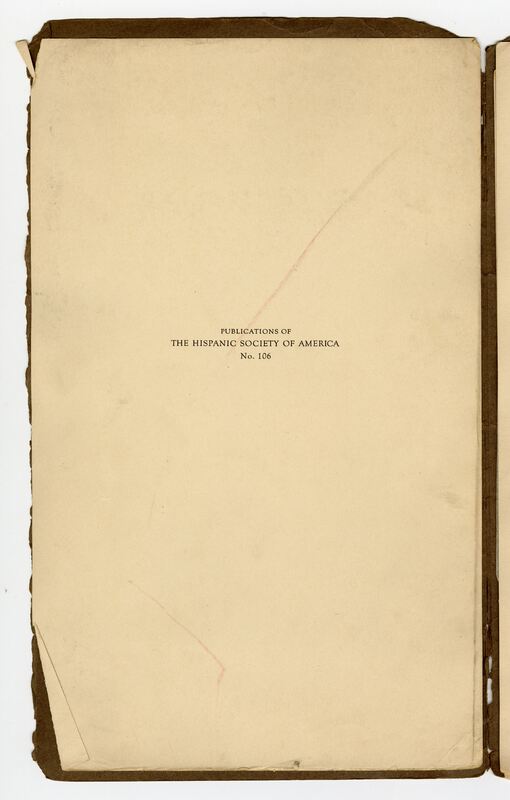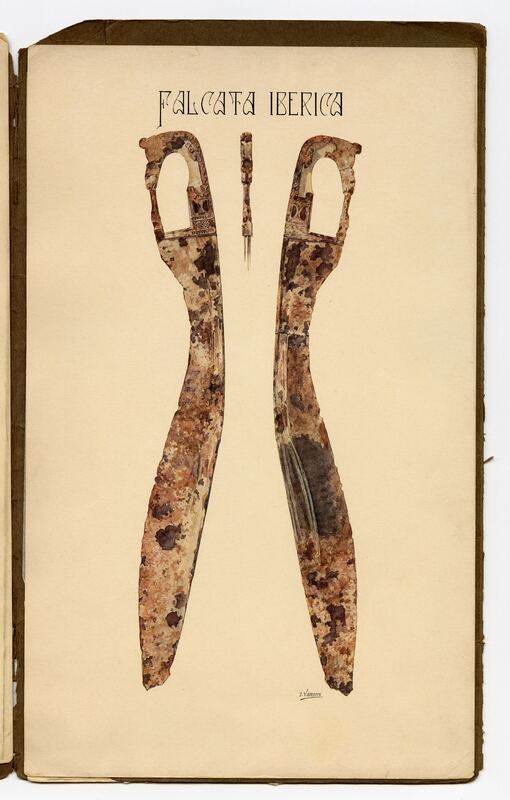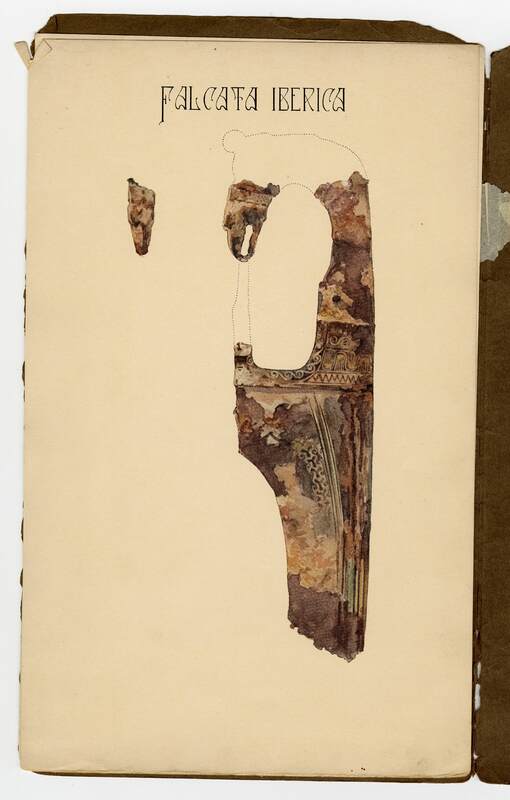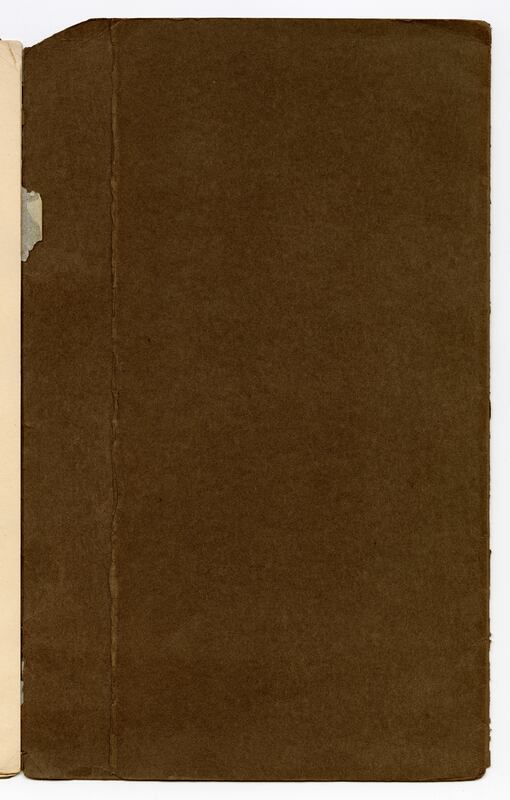Falcata Iberica- Museo Arquelogico de Madrid
Item
- Title
- Creator
- Contributor
- Date
- Description
- Publisher
- Type
- Extent
- Language
- Format
- Identifier
- Subject
- Illustrative content information
- Secondary Features
- Genre/form
- In series
- Publication Information
- Provenance
-
en
Falcata Iberica- Museo Arquelogico de Madrid
-
es
Falcata Iberica- Museo Arquelogico de Madrid
-
en
“Gift of the Hispanic Society of America”
-
es
“Gift of the Hispanic Society of America”
-
en
Illustrations by J. Vargas
-
es
Ilustraciones por J. Vargas
-
en
1916
-
es
1916
-
en
This facsimile created by the Hispanic Society of America reproduces in detail a sword that was native to the Iberian Peninsula during the span of 200-400 AD (scholars believe). These photographic, high quality pages contain color images that fill up almost the whole page. They are hand drawn with colors meant to depict the true appearance of the sword at the time it was illustrated. The “Falcata Ibérica,” which still resides in the Museum of Archaeology in Madrid, came from the Bronze Era, and was found in Cordoba, a region of present day Spain. Yet, the artifact would have been in use before the nation of Spain was unified, thus it would have been used by members of the Iberian tribe, a people indigenous to the Iberian Peninsula. Remember that during these times, there were many wars and much violence in the Iberian Peninsula between those tribes indigenous to the region. Thus, a weapon such as this one would have been a large part of the culture of the peninsula at the time. This piece is contained in a folder that says “Falcata Iberica: Museo Arqueológico de Madrid” in which there are the three pages containing the images and some coversheets. Also, there is a page that states that this facsimile was published by the Hispanic Society of America in New York City. It was given as a gift in 1932 to the university by the society. Through this, it’s evident that the only owner before the university was the society. This piece is the 106th copy of the collection, yet it is not clear the total number of copies of the piece. The paper is of high quality thus making it evident that these images were to be preserved. There is much detail in the drawings of the sword with the colors and texture. The piece was drawn by J. Vargas.
-
es
Este facsímil de la Hispanic Society of America reproduce en detalle una espada de la Peninsula Ibérica de los años 200-400 (creen los sabios). Las láminas del facsímil, impresadas en papel fotográfico de alta calidad, contienen imágenes a color que imágenes llenan casi toda la página. Son dibujados a mano con colores que representan el aspecto verdadero de la espada. La “Falcata Iberica,” que todavía está alla en el Museo Arqueologico de Madrid, era de la edad de Bronce, y viene de Córdoba, una región en la Peninsula Ibérica. Esto fue antes que la unificación de la nación España en la península, entonces viene de una tribu Iberica. Recuerda que durante estos tiempos en la Península Ibérica, había muchas guerras y violencia entre de las tribus indígenas de la península. Entonces, un arma así hubiera sido una gran parte de la cultura en la península. Se contiene esta obra un folleto que dice “Falcata Iberica: Museo Arqueológico Madrid” en que hay tres láminas y unas caratulas. También, tiene una página que dice que este facsímil fue publicado por la Hispanic Society of America en Nueva York, Nueva York. Fue donado como un regalo en 1932 a la universidad por la Sociedad Hispánica de América. A través de esto es evidente que el único dueño antes que Washington and Lee fue la Hispanic Society of America. Es la copia 106 de la colección, pero no es claro el numero total de copias de “Falcata Iberica.” El papel que se usó es de calidad alta y es evidente de esas imágenes debían ser preservadas. Hay mucho detalle en el color y la textura de la espada que fue dibujada por J. Vargas.
-
en
G.P. Putnam’s Sons
-
es
G.P. Putnam’s Sons
-
en
Facsimile
-
es
Facsimíl
-
en
3 loose plates in a slipcover; 2 transparent sheets inserted between pages
-
es
3 láminas sueltas en un estuche; 2 hojas transparentes insertadas entre las láminas
-
en
Spanish and English
-
es
Español e inglés
-
en
8 ¾ in x 13 ½ in
-
es
8 ¾ in x 13 ½ in
-
en
Rare folio DP44.M15
-
es
Folio raro DP44.M15
-
en
This material is made available for use in research, teaching, and private study, pursuant to U.S. Copyright law. The user assumes full responsibility for any use of the materials, including but not limited to, infringement of copyright and publication rights of reproduced materials. Any materials used should be fully credited with the source. Permission for publication of this material, in part or in full, must be secured with the Head of Special Collections.
-
es
Este material se ha hecho disponible para uso en investigaciónes, tanto académicas como privadas, y en la docencia, de conformidad con la ley de derechos de autor de EE. UU. El usuario asume toda la responsabilidad por cualquier uso de los materiales, incluida, entre otras, la infracción de los derechos de autor y los derechos de publicación de los materiales reproducidos. La fuente de cualquier material utilizado debe acreditarse claramente. El permiso para la publicación de este material, en parte o en su totalidad, debe obtenerse de el/la/le Jefe de las Colecciones Especiales de WLU.
-
en
2 colored images
-
es
2 láminas a color
-
en
W&L Library acquisition card in the inside cover
Library Stamp: “May 24, 1932”
Penciled note that indicates that it was given to the university by the Hispanic Society of America
-
es
Tarjeta de adquisición de la biblioteca W&L en la cubierta interior
Estampa de la biblioteca: “May 24, 1932”
Nota en lápiz que indica que fue dado a la universidad por “The Hispanic Society of America”
-
en
Archaeologic Reproduction
-
es
Reproducción arqueológica
-
en
“Publications of the HSA” #106
-
es
“Publications of the HSA” #106
-
en
Place of Publication: New York
-
es
Lugar de publicación: New York
-
en
Gift of the Hispanic Society of America
-
es
Regalo de “The Hispanic Society of America”

